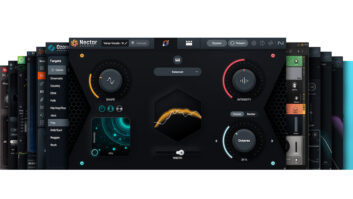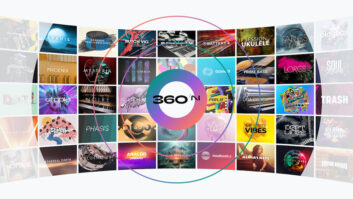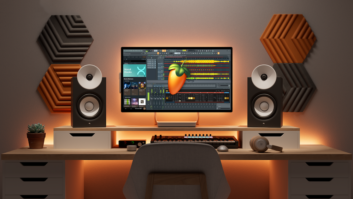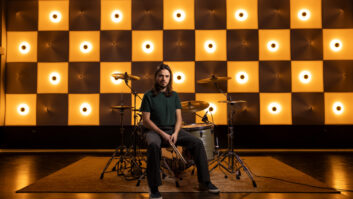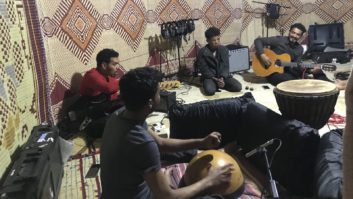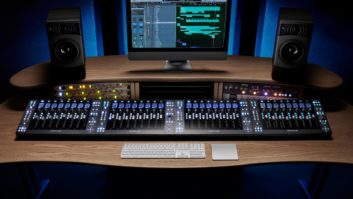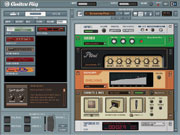
A few of Guitar Rig’s “stomp boxes” and other effects
Who needs yet another guitar amp simulator/multi-effects box? When it’s done this well, the answer is — we do! Native Instruments’ Guitar Rig is both stand-alone and plug-in software that chains together numerous virtual guitar stomp boxes, amps, cabinets, mics and studio effects in any order you wish. Applications include rehearsing, live performances, real-time recording and re-amping existing tracks. Version 1.1.2 (reviewed here) included emulations of four tube amplifiers, most of them offering multiple preamp channels; 14 cabinets; five mics (with a choice of five virtual mic positions); and 23 effects units. Guitar Rig’s interface affords real-time parameter control using the included Rig Kontrol hardware or any MIDI controller. At the 2004 AES convention, I heard four great-sounding distortion units planned for V. 1.2.
Guitar Rig ships in VST, AudioUnits, RTAS and DXi formats. The software requires a 733 MHz PowerMac G4 or faster running Mac OS 10.2.6 or higher (a 1GHz G4 running Panther is recommended) or a 700MHz Pentium III or 1.33GHz Athlon XP processor (1.5GHz processor recommended) running Windows XP. You’ll also need at least 128 MB of RAM (256 and 512 MB recommended for PC and Mac users, respectively). I reviewed Guitar Rig primarily as a plug-in in Digital Performer (DP) V. 4.12 using a dual-processor 867MHz G4 running OS 10.2.8 and 1.8 GB of RAM.
Guitar Rig uses component modeling to emulate tube amplifiers and effects units, as well as filters designed from analyzed impulse responses to emulate various cabinet and microphone combinations. The software requires low-latency ASIO or Core Audio drivers to avoid audible delays on throughput. With DP’s buffer set to 128 samples, I couldn’t hear any latency while playing my Strat through Guitar Rig.
SPLIT PERSONALITY
Guitar Rig’s GUI is essentially divided into two side-by-side frames. The right frame is a virtual rack, in which the various components (amps, cabinets, mics and effects) that make up the current preset are displayed and their parameters edited. The left frame shows a list of banks and presets (up to 128 presets per bank), a search facility for presets, controller assignments for the current preset’s parameters, preference settings and lists of components that you can assemble to create/modify a preset.
Guitar Rig’s available components include amps, cabinets and mics; distortion boxes; modulation effects (including sub-octave generator and tempo-syncable tremolo, phaser, chorus, flange and rotating speaker simulator); filters (equalizers and wah-wah pedals); dynamics processors (compressor, limiter, noise gate and volume pedal); and miscellaneous processors. Simply drag and drop components into Guitar Rig’s rack — and rearrange their order as desired — to create your own preset or modify an existing preset. The signal splitter can be used to chain components in parallel signal paths. All components have adjustable controls for their numerous parameters, and each component’s parameter settings can be saved as a template for later recall. Guitar Rig allows 20 levels of undo/redo, but there is no Compare function.
Guitar Rig’s rack also includes master input and output level modules, a tuner, a metronome (which can sync to the host’s tempo and import percussive audio files) and two “Tapedecks.” The latter can play imported .WAV, .AIFF, .AIF or MP3 files (including supplied loops) and perform 16-bit sound-on-sound overdubs (unlooped only) of your live playing. Mostly useful in Guitar Rig’s standalone application, the Tapedecks cannot sync their playback to a host DAW’s transport.
PUTTING YOUR FOOT DOWN
Rig Kontrol can operate as a DI without foot controllers for two guitars, each having its own discrete signal path in Guitar Rig. (Guitar Rig can accept either mono or stereo input and always outputs in stereo.) Alternatively, Rig Kontrol can function as a DI with foot controllers for one guitar. In the latter case, the control signals from the unit’s four footswitches and one footpedal get recorded to one side of a stereo track in your DAW. (Recording the control signal thus provides one method — in lieu of recording MIDI controllers or automation envelopes — to automate Guitar Rig.) Each controller can be assigned to one parameter in any preset. Parameter ranges can be scaled.
Rig Kontrol can be powered by a 9-volt battery or a user-supplied AC adaptor. Unfortunately, the unit provides only enough output level to provide 0dBFS input to -10dBV nominal A/D converters and I/O boxes; all I/O are unbalanced phone jacks.
I set up Rig Kontrol so that two footswitches advanced and retrograded, respectively, through consecutive presets in a loaded bank. The two remaining footswitches switched between clean and gritty amplifier modes. I used the footpedal to modulate either volume pedal level or wah-wah frequency.
CONCLUSIONS
Although many of Guitar Rig’s tones are somewhat crispy when the input source is Rig Kontrol, they can be warmed up by using a tube preamp’s DI or a miked speaker as input source. Aside from a couple of minor bugs in V. 1.1.2 (which should be fixed in V. 1.2), operation was user-friendly. Most importantly, latency is not an issue and Guitar Rig’s countless tonal variations give guitar tracks multiple personalities that would make Sybil swoon. At $499, Guitar Rig rocks!
Native Instruments, 866/556-6487, www.native-instruments.com.
